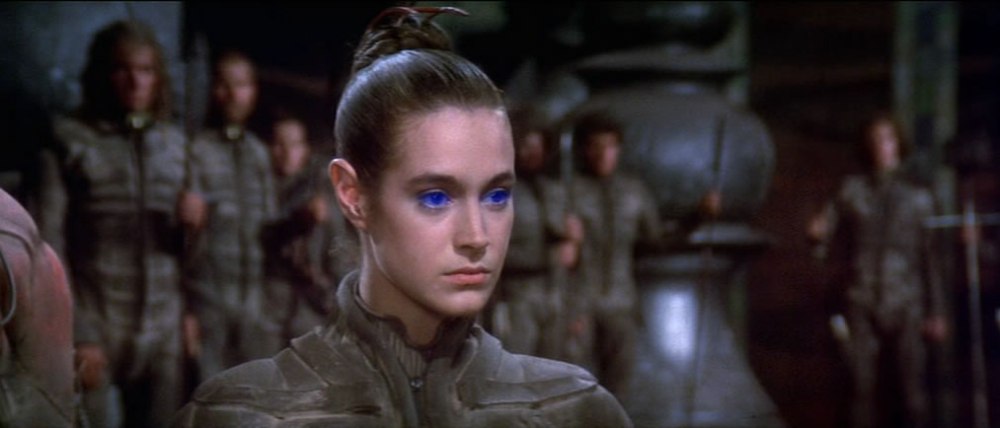Narcotic dullness filled her eyes … Her awareness lay deep within the Semuta, lost somewhere and riding the ecstasy of the music.
Dune Messiah (1969) by Frank Herbert

I recently spent an afternoon with a friend who subscribes to Google Play Music. For £9.99 a month, he has perpetual access to pretty much any commercially-produced music he’d care to hear: from classical to jazz; from 60s psychedelia to 80s glam-rock; from 90s EDM to the current Top 40.
Everything.
So why, I wondered, did it all sound the same?
Part of the answer is to be found in the algorithmic feedback loops employed by Facebook, Google, Youtube and the like to keep us hooked. Google Music observes your listening habits and creates playlists for you consisting of more of the same sort of music. You’re doubtless familiar with the process. You might have purchased a Sci-Fi novel on Amazon and found that the site begins recommending more Sci-Fi novels for you.

 As Adam Curtis, director of Hypernormalisation, Bitter Lake and The Century of the Self puts it:
As Adam Curtis, director of Hypernormalisation, Bitter Lake and The Century of the Self puts it:
The algorithms are so strong, and know so much about you, that they only give you what they know you like. You have become trapped in an echo chamber. But all you see and hear is you.
It’s fabulously clever technology. It’s also a dangerously compelling path to creative inertia. It becomes too easy not to seek new, challenging music; too easy to always expect the same experience from music; too easy to descend into a deep rut with slippery sides.
If every human in the world subscribed to Google Music (which is probably Google’s endgame) then we would become culturally compartmentalised. People would only ever be exposed to sonic art from a very narrow sample-field and find it increasingly difficult to understand and relate to any other sort of music and those who listened to it. If we couple this with the political compartmentalisation produced by Facebook in our dystopian future, might we over many generations reduce humanity’s capacity for empathy? How can someone who has only ever spoken with Republicans and listened to Country and Western have a meaningful conversation with a Democrat who listens to Acid Jazz?

The other reason all the Google Music my friend played sounded the same was this:
Anything recorded before about 1997 (the year of the invention of Autotune) had been re-mastered to make it sound glossy and diamond-sharp – in short, to make it sound like it had been recorded in the last 20 years. The warmth of vinyl records that Shoreditch Hipsters are often to be overheard discussing is replaced by a more polished but somehow colder, less human audio aesthetic. Some of it, I couldn’t help suspecting, might even have been subtly quantised to allow one track to flow seamlessly into the next like a robotic DJ set.
If you are unclear about what quantisation is, this guy explains it quickly in a nutshell:
So perhaps my earlier postulations about the compartmentalisation of music are a little off the mark. Could it be that the future of music that awaits us is one of uniformity?

Might our children try to listen to, for example, Pink Floyd’s Dark Side of the Moon and only be able to hear a quantised, Autotuned re-master on Google, which has by that point monopolised access to music? Maybe my grandchildren will gather round me in hushed, incredulous awe as I play the original 1977 vinyl-rip of Bob Marley’s Exodus on my battered old iPod, only to wander off after the first minute, their eroded attention spans pulling their focus back to the tablets embedded in their eyelids.
Just for fun:
In the hugely influential 1965 epic sci-fi novel Dune, inspiration for Star Trek, Star Wars,  The Matrix and, come to think of it, most science fiction, author Frank Herbert (1920-86) introduces us to the hypothetical drug Semuta. The effect, described as timeless, sustained ecstasy, is elicited by certain atonal vibrations, an ‘eerie, wailing’ music.
The Matrix and, come to think of it, most science fiction, author Frank Herbert (1920-86) introduces us to the hypothetical drug Semuta. The effect, described as timeless, sustained ecstasy, is elicited by certain atonal vibrations, an ‘eerie, wailing’ music.
While this may sound like pure futuristic fantasy, a comparable technology has in fact existed since 1839. Prussian physicist Heinrich Wilhelm Dove (1803-79) discovered that if he played two tones of slightly different frequencies, one in each ear, the phenomenon of ‘binaural beats’ could be achieved. The brain perc eives the two frequencies as one pulsing tone. Musicians will be familiar with this effect as the wavering sound produced by two instruments tuning to the same note, the wavering becoming increasingly rapid as the two pitches converge until indistinguishable.
eives the two frequencies as one pulsing tone. Musicians will be familiar with this effect as the wavering sound produced by two instruments tuning to the same note, the wavering becoming increasingly rapid as the two pitches converge until indistinguishable.
This is all very well, but how does it produce Frank Herbert’s ‘sustained ecstasy’ of Semuta?
Well, during meditation, the brain produces a low-frequency vibration, 10Hz to be precise, which stimulates the release of serotonin (the happiness neuro-transmitter). If you were to play a 200Hz tone in one ear and a 210Hz tone in the other, your brain would process the two as a 10Hz frequency, promoting serotonin release and, over a sustained period, inducing a meditative state.
If you have 10-20 minutes spare, try it out. (N.B. You will need to listen with earphones.)
It can purportedly be used to counteract the effects of hangover and jet lag, too!
So that’s as close as we can currently get to Semuta. But it’s hardly beyond the realms of possibility that a service like Google Music could begin combining binaural beats with music. Whether this would be beneficial for customers or produce a very lucrative dependency like Frank Herbert’s addictive Semuta remains to be seen.
I’d like to finish this article by combatting the algorithms that would have you endlessly listening to Simon Cowell pop. To do so, I will point you in the direction of some music you might never have heard before. Here are three examples of what I think the Semuta music of Dune might sound like.
First, let me introduce American pianist and composer David Tudor (1926-96) and his synthesised soundscape Rainforest (1968).
Using only synthesisers, Tudor recreates the ambience of a rainforest: its intoxicating heat, its alluring bird calls, its saturated sonic habitat. It’s not hard to picture Dune aliens lolling in Semuta stupor to the sound of this immersive, exotic electronica.
Next is something a little more unearthly from another American composer, Morton Subotnick (b.1933). This is his 1967 lunar odyssey, Silver Apples of the Moon:
Here, surely, is the eerie, atonal wailing that Frank Herbert had in mind.
And finally, let’s give Silver Apples of the Moon a 21st Century update. The Semuta drug which Semuta Music accompanies might be most analogous today to MDMA (a.k.a. Ecstasy, Mandy, Meow Meow). This is the drug of choice with trendy young club-goers for whom its magnification of sensory perception is best coupled with loud, insistent music, hours of uninhibited dancing and the pungent aroma of sweat. For a more cerebral rave experience, connoisseurs turn to English composer Richard D. James, alias Aphex Twin.
Here is his track Ziggomatic V17 from the 2001 album Drukqs:
The irony here is that in Dune, anything with a consistent rhythm, like this Aphex Twin track, would attract the dreaded and ravenous sandworms. Unless you happen to be more than 250m in height, this is bad news.
Much love from Will x
P.S. For more thoughts on social media algorithms and their effects on our lives, see this illuminating TED Talk: